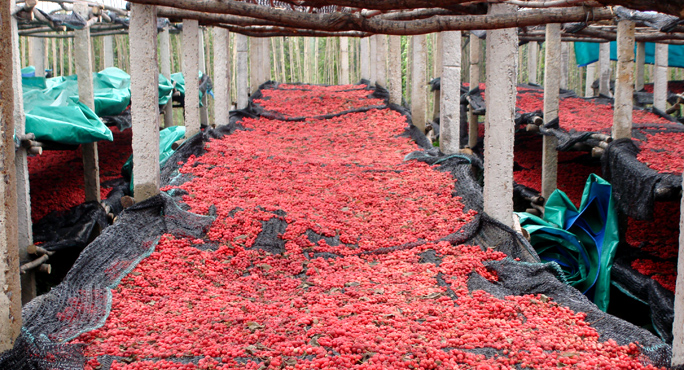Schisandra Berries Drying in Northern China. Photo by Chris Kilham
This week Boulder, Colorado, is packed with natural food and lifestyle advocates and luminaries as the LOHAS Forum, a gathering of health and sustainability professionals, gets under way. Today I had the opportunity to hear Chris Kilham—founder of Medicine Hunter, TV personality and author of 14 books on natural health and plant-based medicines—speak as part of the Highland City Club LOHAS Luncheon Series. Kilham made me want to immediately run out and get some schisandra, indulge more often in chocolate and learn more about the psychoactive plant Trichocereus pachanoi, known as San Pedro Cactus. These three plants, Kilham says, illustrate his work as a medicine hunter.
Schisandra (Schisandra chinensis):
Kilham calls schisandra chinensis “the superset of the super berries” and says it could be used instead of many of the psychiatric medicines we use today—without the onerous side effects. Native to China, the “five-flavored berry” helps relieve mental and physical stress. It is said to prolong life, retard aging, fight fatigue, enhance sexual health and sharpen concentration and focus. “You may be thinking, I don’t know of any drug that does all these things, and you’re right,” Kilham says. Schisandra is not a household staple in the United States, he says, because there’s no profit in it—it can’t be patented. “There’s just no interest, even though this could radically enhance everyone’s quality of life,” he says. “It could actually prevent kids from being put on Ritalin and other drugs.”
Cocoa/Chocolate (Theobroma cacao):
Theobroma cacao, literally “food of the gods,” is another beloved plant that Kilham would like to see more people utilizing. Packed with antioxidants, cacao is anti-inflammatory, lowers lipids, fights cancer and spasms, and is an aphrodisiac. Chocolate “messes with your brain soup,” Kilham says, by producing cannabanoids that create feel-good dopamine—perhaps why many women turn instinctively to chocolate just before menstruation, when dopamine levels are lowest). “This is great news for chocolate lovers,” Kilham says. The magic happens only with semi-sweet dark chocolate or raw cacao, which can be thrown into a shake. Milk chocolate doesn’t have enough cocoa solids to be of benefit. (Hey, no worries. We’ll eat the dark chocolate.)
San Pedro Cactus (Trichocereus pachanoi):
And finally, Kilham talked a bit about his work with psychoactive plants, including trichocereus pachano, or San Pedro cactus, which contains mescaline. The plant is legal, but boiling and drinking it to produce hallucinogenic visions is not, Kilham says. Research into psychoactive plants dried up in the early 1970s when the drug war was launched, but Kilham says a good body of knowledge is now being developed. “We still have a lot of unanswered questions,” he says, “but we’re clearly onto something with using sacred plants to treat addictions.”


